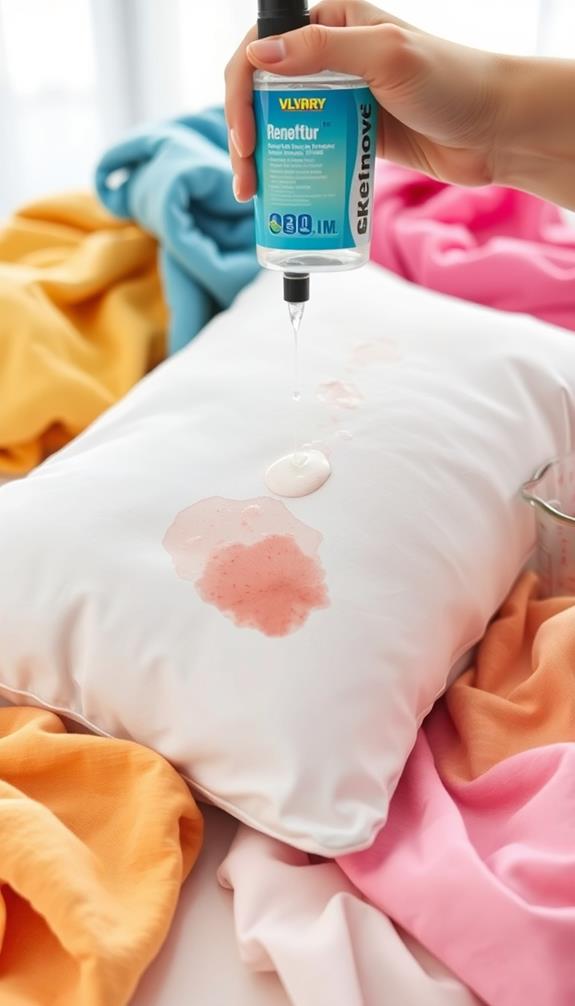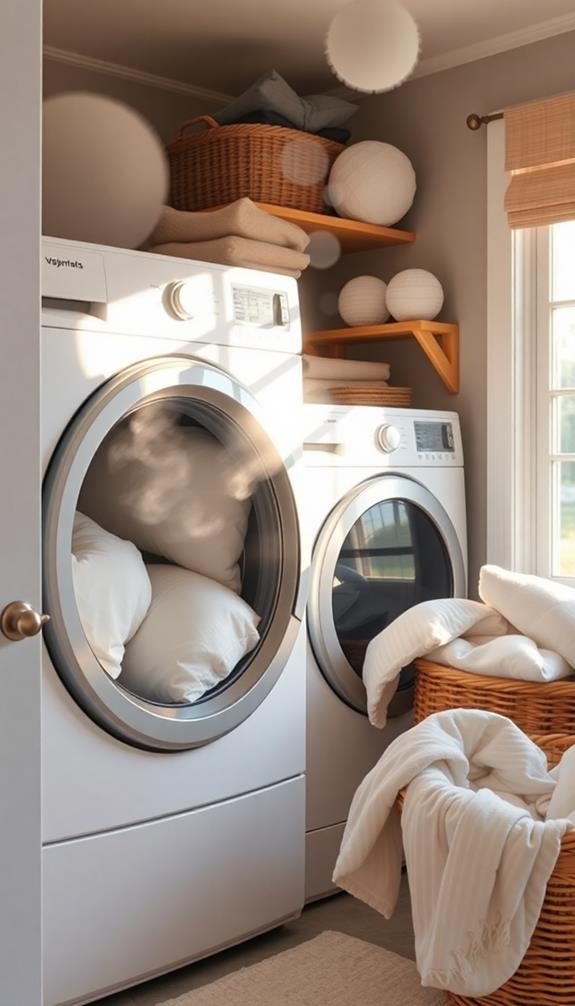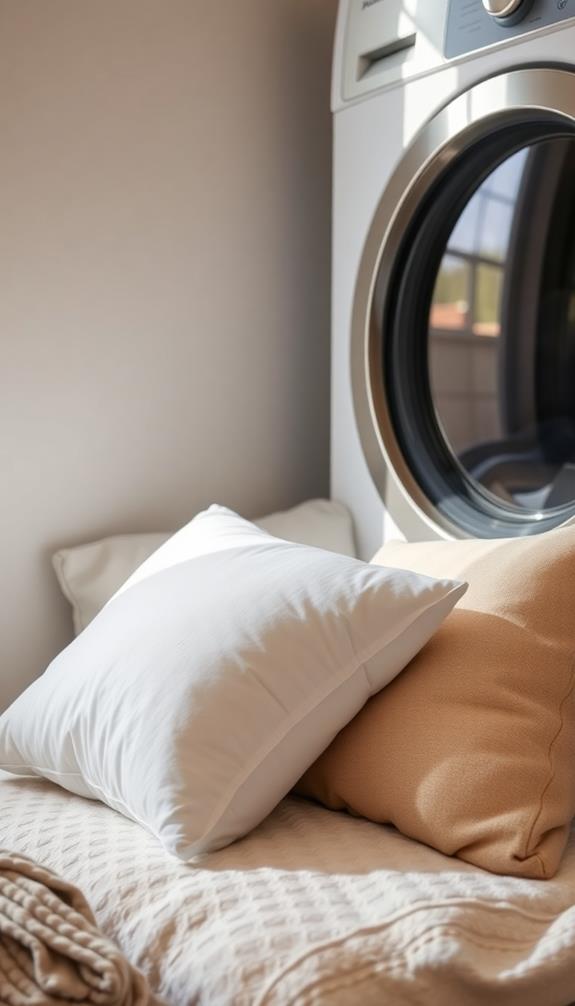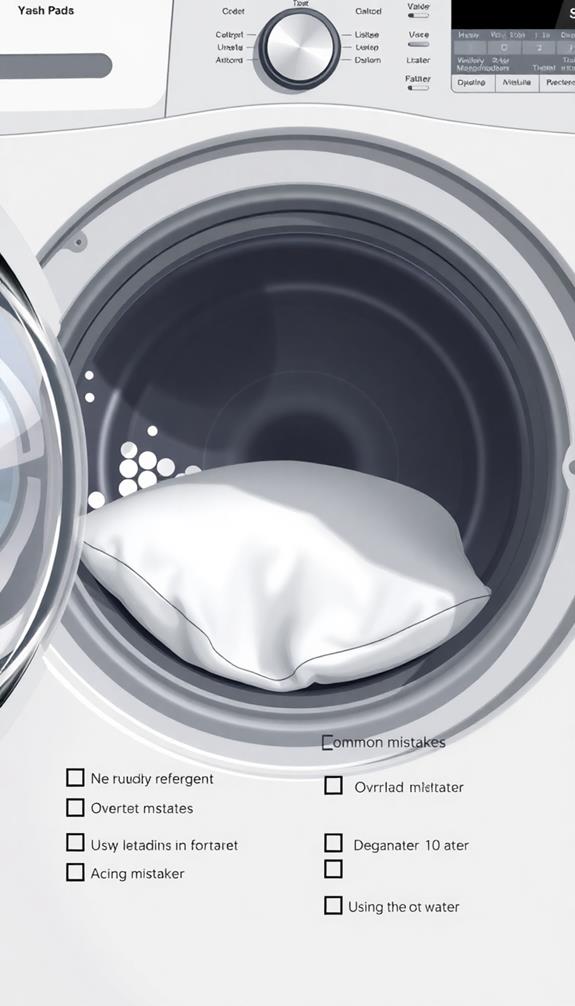To wash pillows in a front-loading washer, start by checking their care labels to confirm they're machine washable. Pre-treat any stains using a suitable solution, allowing it to sit for a few minutes. Load your pillows into the washer and select a gentle cycle with warm water and mild detergent. Avoid bleach and fabric softeners. Once washed, dry them on a low heat setting with dryer balls to maintain shape, checking every 30 minutes to ascertain they're fluffy and completely dry. Follow these steps, and you can guarantee a cleaner, healthier pillow for a restful sleep. You might find even more helpful tips ahead.
Importance of Washing Pillows
Washing your pillows regularly is vital for maintaining a healthy sleep environment. Over time, pillows can accumulate dirt, sweat, and body oils, which can lead to the buildup of allergens and dust mites. This is particularly important if you suffer from allergies, as the Asthma & Allergy Foundation recommends frequent cleaning and replacement of pillows to improve your sleep hygiene.
By washing your pillows every 3 to 6 months, you not only enhance comfort, but you also prolong their lifespan. Regular cleaning helps keep your pillows fluffy and fresh, preventing discoloration and unpleasant smells. Additionally, using non-toxic cleaning solutions can further guarantee a healthier sleeping space by minimizing exposure to harmful chemicals.
It's imperative to tackle the dead skin and bacteria that can thrive in your bedding, as this buildup can greatly impact your overall health. Maintaining awareness of how to wash your pillows can assure you enjoy better sleep quality without the need for premature replacements.
Incorporating this simple habit into your routine can lead to a cleaner, more comfortable sleeping environment, allowing you to wake up feeling rejuvenated. So, make washing your pillows a priority, and enjoy the benefits of improved hygiene and a more restful night's sleep.
Checking Care Labels
How can you confirm your pillows are cleaned properly without risking damage? The answer lies in checking the care label. Before washing pillows, always look at the care instructions to determine if they're machine washable or if they need special care, like dry cleaning.
Most synthetic and down pillows can go in the washer, but memory foam and latex often require spot cleaning or hand washing. Maintaining a clean environment for your bedding is vital, as regular cleaning routines not only promote hygiene but also prolong the life of your pillows.
Following the care label's specific instructions is fundamental for effective cleaning. Ignoring these guidelines might lead to discoloration, shrinkage, or even loss of shape, leaving your pillows less comfortable than before.
Some pillows also have unique requirements; for instance, they might need you to use a mild detergent, avoiding bleach and fabric softeners. This guarantees that the materials remain intact and your pillows stay in great condition.
Pre-Treating Stains

Before you wash your pillows, check for any visible stains that need attention.
Apply a suitable stain treatment, like laundry detergent or a vinegar mix, directly onto the stains and gently rub it in.
Don't forget to let the treatment sit for 5-10 minutes to guarantee it works effectively before tossing your pillows in the washer.
Identify Stain Types
Identifying the types of stains on your pillows is essential for effective pre-treatment. Common culprits include sweat, body oils, food stains, and beverage stains. Each type requires a different approach to maximize your cleaning efforts.
For sweat and body oils, you can use laundry detergent. Apply a small amount directly to the stained area and gently rub it with your fingers to break down the oils. This method helps lift those stubborn stains before washing.
When it comes to food stains, a mixture of water and white vinegar works wonders. Apply the solution and let it sit for a few minutes to enhance stain removal.
For beverage stains like coffee or juice, reach for a stain remover or create a paste with baking soda and water. Apply this directly to the stain and let it sit for several minutes before rinsing.
Always check the care label on your pillows before starting any pre-treatment. This guarantees you use methods that won't damage the material, helping you keep your pillows looking fresh and clean for longer.
Apply Stain Treatment
To effectively tackle stains on your pillows, start by applying a stain treatment as soon as you spot them. First, inspect your pillows for any visible stains, whether they're from sweat, food, or bodily fluids.
Once you've identified the stains, grab your liquid laundry detergent or a specialized stain treatment. Apply a small amount directly onto the stain, ensuring it's adequately covered for maximum effectiveness.
Next, use your fingers or a soft cloth to gently rub the treatment into the fabric. This helps lift the stain from the pillow material, enhancing the cleaning process. Be careful not to rub too hard, as you don't want to damage the fabric.
After you've worked the treatment in, allow it to sit for about 5-10 minutes. This waiting period is essential, as it lets the treatment penetrate and break down the stain effectively.
For the best results, make sure your pillows are cleaned promptly after applying the stain treatment. The sooner you wash them, the less likely the stains will set, ensuring your pillows come out looking fresh and clean.
Allow Treatment Time
After applying the stain treatment, it's important to let it work its magic. Take a moment to verify the treatment has been applied directly to the stained areas, as this will enhance the cleaning process.
Gently rub the treatment into the stain using your fingers to help it penetrate deeper, allowing for better results when you eventually wash your pillows.
Give the stain treatment at least 5-10 minutes to break down the stain effectively. This time is essential; rushing the process could lead to disappointing cleaning outcomes.
If you're dealing with tough stains, consider mixing natural ingredients like vinegar or baking soda with your regular detergent for even better stain removal.
Allowing the treatment to sit not only treats the stains but also helps prevent any permanent marks or discoloration on your pillows.
Once the time is up, you're ready to wash. Follow this step diligently, and you'll find that your pillows come out looking fresher and cleaner than ever, free from unsightly stains.
Washing Method
When it comes to washing your pillows, you can choose between machine washing and hand washing.
Using a front-loading washer is ideal for maintaining their shape and integrity, while hand washing might be better for delicate materials.
To guarantee your pillows remain fresh and clean, it's important to act quickly when dealing with any stains, just as you'd with car upholstery quick action is essential.
Let's explore the best techniques for each method to keep your pillows fresh and clean.
Machine Washing Techniques
Typically, washing pillows in a front-loading washer is a straightforward process that assures they stay fresh and clean.
Start by checking the care label to ascertain your pillows are machine washable. Always wash at least two pillows at a time to keep the load balanced and prevent damage. Set your washing machine to a gentle cycle with warm water and use a mild detergent—skip bleach and fabric softeners, as they can weaken the fabric.
To enhance the washing process, consider these tips:
- Allow pillows to soak initially by pausing the cycle.
- Run an extra rinse cycle for thorough cleaning.
- After the wash, use an additional spin cycle to remove excess water.
- Add dryer balls during the drying process to help fluff the pillows.
Once washed, get ready to dry your clean pillows.
Place them in the dryer on a low heat setting, and make sure to monitor them to prevent overheating.
With these machine washing techniques, you'll have fresh, clean pillows that are ready for a good night's sleep!
Hand Washing Guidelines
If you prefer a more hands-on approach to caring for your pillows, hand washing can be an effective method, especially for delicate materials like memory foam and latex.
Start by filling a bathtub with lukewarm water and adding a mild detergent according to the care instructions. Allow your pillows to soak for 15-20 minutes to loosen dirt and debris.
After soaking, gently squeeze and press the pillows to remove any buildup. Avoid wringing or twisting them, as this can compromise the integrity of the foam.
Once you've cleaned them thoroughly, rinse the pillows with clean water to guarantee all detergent is removed. Any leftover soap residue can affect comfort and performance.
To get rid of excess water, gently squeeze the pillows again without submerging them completely.
Finally, place the pillows in a well-ventilated area to air dry, flipping them occasionally for even drying. Avoid direct sunlight during this process to prevent damage.
Hand washing, when done correctly, keeps your pillows fresh and prolongs their lifespan, offering you the comfort you deserve.
Drying Techniques

Properly drying your pillows is essential to maintaining their shape and hygiene. After washing, place your pillows in the dryer on a low heat setting. This helps to prevent damage and guarantees they dry thoroughly without clumping.
For ideal cleaning results, it's important to master vacuuming techniques before tackling your bedding. Use dryer balls or clean tennis balls in the dryer to help maintain their shape during the drying process.
Here are some tips to keep in mind:
- Check your pillows every 30 minutes; drying can take up to two hours, depending on the type and thickness.
- Rotate your pillows every hour to guarantee even drying and avoid moisture retention that can lead to mold growth.
- If you choose to air dry, place your pillows in a well-ventilated area and turn them occasionally for even drying.
- After the drying cycle, verify your pillows are fluffed and check for any clumping before putting them back on your bed.
Maintenance Tips
Maintaining your pillows is just as important as washing and drying them. To keep your pillows in top shape, regularly fluff them every few days. This simple act helps maintain their shape and comfort, preventing them from becoming flat.
Additionally, changing your pillow covers frequently can reduce allergens such as dust mites and improve overall hygiene, as recommended in the recommended frequency for changing bed linens. Using pillow protectors is another essential maintenance tip; they make it easier to keep your pillows clean and reduce the frequency with which you need to wash your pillows.
Every few months, inspect your pillows for signs of wear and tear, such as lumps or discoloration. If you notice significant damage, it might be time to replace them.
While you don't need to wash the entire pillow frequently, you should wash the pillow covers according to the care instructions to maintain hygiene.
To keep your pillows fresh between washes, air them out in sunlight occasionally. This can help eliminate odors and refresh their feel without resorting to deep cleaning.
Types of Pillows

When choosing pillows, it's essential to understand the different types available and how they suit your sleeping needs. Each pillow type has unique characteristics that affect care and maintenance, especially when it comes to washing your pillows.
Regular cleaning can help maintain hygiene and comfort, similar to how eco-friendly alternatives can help maintain your kitchen appliances.
- Synthetic Pillows: Machine washable and dry quickly, making them easy to maintain. Aim for cleaning every 3-6 months.
- Memory Foam Pillows: Require spot cleaning only. Machine washing can degrade them, so follow specific care instructions to keep them in good shape.
- Feather and Down Pillows: Washable in a front-loading machine, but they may need extra drying time to prevent clumping and mold growth.
- Latex Pillows: Not washable. Instead, wipe them down with a damp cloth to keep them clean.
If you own buckwheat pillows, remember that their hulls can be removed and washed separately, while the fabric cover should be spot cleaned.
Always check the care instructions for each pillow type to guarantee proper maintenance. By understanding these types, you can make informed decisions for your comfort and hygiene.
Washing Frequency
Washing your pillows regularly is essential for ensuring a clean and comfortable sleep environment. To maintain hygiene and remove accumulated allergens and odors, you should wash pillows used nightly every three to six months. This routine not only keeps your pillows fresh but also extends their lifespan, allowing you to enjoy better sleep quality.
Following care label instructions and using mild detergents can help preserve the integrity of your pillows while effectively removing germs and allergens, making it important to refer to effective washing techniques.
If you're using pillows in a guest room, you can wash them less frequently—typically once a year—unless you notice signs of staining or unpleasant odors. Look out for yellowing, a musty smell, or if your pillows feel uncomfortable or flat; these are clear indicators that it's time to wash them.
For individuals with allergies, the Asthma & Allergy Foundation recommends replacing pillows every 1.5 to 2 years to prevent bacteria buildup. By keeping to this washing frequency, you can create a healthier sleep environment and protect yourself from potential allergens.
Common Mistakes

Have you ever wondered why your pillows don't feel as clean or fresh as they should? It might be due to some common mistakes you're making during the washing process.
To wash pillows the right way, pay attention to the care labels and follow the manufacturers' instructions. Ignoring these guidelines, especially for delicate materials like memory foam or latex, can lead to damage.
Additionally, optimizing washing habits can greatly enhance the cleaning results of your pillows.
Here are some key mistakes to avoid:
- Washing only one pillow at a time can unbalance your washer, leading to inadequate cleaning.
- Failing to pre-treat stains can leave stubborn marks that compromise cleanliness.
- Skipping the extra rinse cycle may cause detergent residue, irritating sensitive skin.
- Not using dryer balls or tennis balls while drying can lead to clumping and loss of shape.
Final Touches
Once you've finished washing and drying your pillows, it's time to give them some final touches to guarantee they're as fresh and comfortable as possible.
Start by removing the pillows from the dryer and fluffing them by hand. This helps restore their shape and guarantees the filling is evenly distributed, enhancing your comfort.
Next, inspect the pillows thoroughly for any signs of moisture. If they feel damp, pop them back in the dryer on low heat for 15-minute increments until they're completely dry.
After drying, let the pillows air dry for a few hours to guarantee they're fresh and ready for use.
While you're at it, take a close look at the pillows for any rips or lumps. If you notice wear and tear, it might be time to contemplate replacing them, especially if they no longer provide adequate support.
To keep your pillows clean longer, think about investing in pillow protectors. These can reduce the frequency of washing and promote overall hygiene, guaranteeing your pillows stay fresh and inviting for restful nights ahead.
Conclusion
Washing your pillows might seem like a hassle, but it's simpler than you think! You'll not only extend their life but also enjoy a cleaner, fresher sleep environment. Don't worry if you're unsure; just follow the steps outlined, and you'll be a pro in no time. Plus, the satisfaction of snuggling into freshly cleaned pillows is worth the effort. So, go ahead—give your pillows the care they deserve and enjoy a better night's sleep!